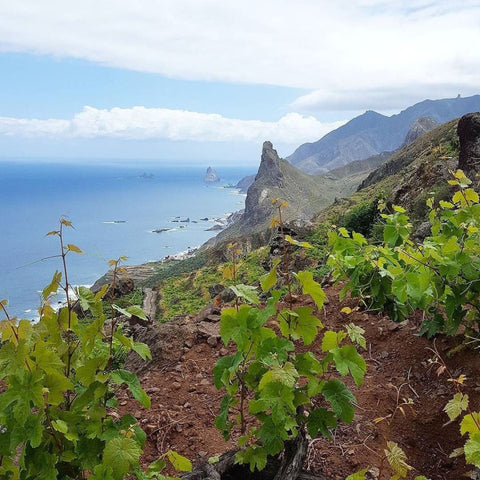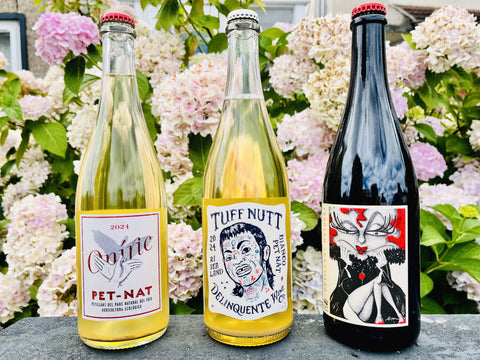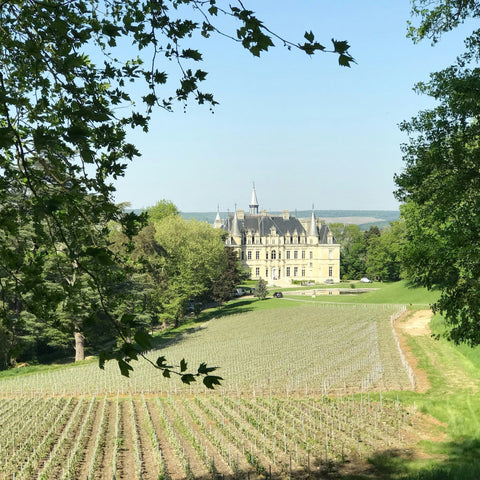Europe's islands are home to a terroir we don't discuss enough, one defined by volcanic soils and sea breezes that leave an unmistakable mark in every glass. These same Mediterranean and Atlantic islands we escape to for holidays, celebrated for their fresh seafood and sunset aperitivos, are quietly producing some of Europe's most important and celebrated wines.
Island winemaking is marked with strong and authentic traditions passed down through generations alongside an understanding of sustainability born from isolation. These producers have always worked in harmony with their environment, and today they're at the forefront of adapting to climate change while preserving ancient practices. The result? Wines that capture something you simply can't find on the mainland: a sense of place shaped by salt air, volcanic earth, and the resilience of island life.
From Sicily's volcanic Etna slopes to Santorini's windswept vineyards, from Sardinia's granite hills to the Canary Islands' volcanic cones, these regions are experiencing a renaissance. Wine lovers are discovering what locals have always known: that island wines offer true authenticity.
At Forest Wines, we love introducing you to bottles you won’t easily find in other wine shops. While we carry the classics from France or Italy, our passion lies in uncovering hidden gems from lesser-known regions, often crafted by small producers dedicated to sustainable and natural winemaking practices.
In this guide, we'll explore our favourite island wine regions across Italy, Greece, and Spain, uncovering the indigenous grapes and unique terroirs that make each one special.
Sicily & Pantelleria: At the forefront of Sustainable winemaking and unique practices
Sicily is home to one of Europe’s most famous active volcanoes: Mount Etna. The island’s food and wine are renowned not only for their deep-rooted traditions but also for a distinct volcanic character that comes from ingredients grown in its mineral-rich soils. This unmistakable flavour is also present in the grapes, and therefore in the wines, produced in the region.
The dramatic elevation changes created by Etna’s volcanic slopes have given rise to a patchwork of microclimates across the island, resulting in wines that are surprisingly diverse and highly expressive of their terroir.
Beyond its unique geography, Sicily is also a leader in sustainable farming and natural winemaking. A new generation of winemakers is breathing life into old vineyards, championing low-intervention methods, and pushing forward the movement for environmentally conscious viticulture.
But Sicily isn’t just the mainland, it’s also a constellation of smaller islands that form part of the region. One of the most remarkable is Pantelleria, a volcanic island located just off the coast of Tunisia. Often called the “Daughter of the Winds,” Pantelleria is home to a viticultural tradition so distinctive that UNESCO has recognized its vine-training method, Alberello Pantesco, as intangible cultural heritage.
To protect the vines from strong winds and retain moisture in the island’s dry climate, growers plant them in shallow, bowl-shaped depressions in the volcanic soil and prune them low to the ground. The wines of Pantelleria are celebrated for their aromatic intensity and rich, honeyed flavours: a true expression of their singular origin.
Key Indigenous Grapes:
-
Nerello Mascalese & Nerello Cappuccio (Red)
Region: Grown on the volcanic slopes of Mount Etna in Sicily.
Character: Light to medium-bodied with finesse and minerality from the volcanic soils.
Flavour profile: Red cherry, wild strawberry, herbs, and dried flowers, with earthy undertones and a touch of smoke.
Pair it with: Grilled lamb, mushroom risotto, charred vegetables, or dishes with umami-rich ingredients.
-
Nero d'Avola (Red)
Region: Widely grown across Sicily, especially in the southeast near Noto and Vittoria.
Character: Bold and juicy, with smooth tannins and dark fruit richness.
Flavour profile: Ripe black cherry, plum, chocolate, and hints of spice or tobacco.
Pair it with: Rich tomato-based dishes, grilled meats, hearty pastas, or even BBQ.
-
Cataratto (White)
Region: Indigenous to Sicily, especially the western part of the island.
Character: Crisp and dry, with medium body and subtle aromatics.
Flavour profile: Citrus (lemon peel), white peach, almond, and light herbal notes.
Pair it with: Seafood pasta, grilled fish, caponata, or young cheeses.
-
Castellana (White)
Region: Native to southern Italy; limited cultivation but gaining attention.
Character: Fresh and delicate, showing good acidity and subtle minerality.
Flavour profile: Pear, green apple, white flowers, and a touch of salinity.
Pair it with: Light antipasti, raw shellfish, or simple vegetable dishes.
-
Zibibbo
Region: Grown on the island of Pantelleria off Sicily's coast.
Character: Lusciously sweet yet balanced with fragrant aromatics.
Flavour profile: Dried apricot, honey, orange peel, jasmine, and candied citrus.
Pair it with: Blue cheese, almond pastries, or as a dessert on its own.
Our favourite Sicilian wines
Sardinia & Corsica
Sardinia and Corsica offer some of the most distinctive wines in Europe, shaped as much by granite-rich soils, coastal breeze, and a climate marked by hot, dry summers tempered by the cooling mistral winds. These natural elements create a unique terroir that brings structure, minerality, and freshness to the wines.
Vineyards here are often planted on rocky slopes or near the sea, where the salty breezes and the sunny days produce grapes of intense character and resilience. Many of the vines, particularly Cannonau in Sardinia, are remarkably old, with some being more than 100 years of age. These deep-rooted vines yield low quantities but deliver remarkable quality and complexity.
Often overlooked over their neighbouring islands like Mallorca and Sicily, these islands have so much to offer when it comes to food and wine products. Their world-renowned cured meats and cheese make for the perfect pairing with the wines from the region.
Key Indigenous Grapes:
-
Cannonau (Red)
Region: Predominantly grown in Sardinia, especially in the central and eastern parts of the island.
Character: Robust and earthy, similar to Grenache, often with a rustic edge and notable depth from old vines.
Flavour profile: Ripe red berries, dried herbs, warm spices, and a touch of Mediterranean garrigue. Can develop leathery, smoky notes with age.
Pair it with: Grilled lamb, aged cheeses, slow-cooked stews, or anything with rosemary, thyme, or wild fennel.
-
Vermentino (White)
Region: Found along the coastal areas of Sardinia and also widely planted in Corsica.
Character: Fresh, zesty, and mineral-driven, with a salty tang from the sea breeze.
Flavour profile: Lemon peel, green apple, crushed rocks, and subtle hints of almond or white blossom.
Pair it with: Shellfish, grilled seabass, herby salads, or light pasta dishes with citrus or olive oil.
Our favourite Sardinian & Corsican wines
Santorini
Santorini is another volcanic island, and arguably the most famous of the Cyclades in the Greek Aegean Sea. Before wine even comes to mind, Santorini brings images of endless white-and-blue houses, romantic sunsets, and striking black-sand beaches, formed from the island’s volcanic pumice and ash. It’s this same volcanic soil that gives Santorini’s wines their distinct and unforgettable character.
The landscape is shaped by intense winds, which have led to a unique vine-training method called kouloura. Much like Pantelleria’s approach, this involves weaving the vines into low, basket-like coils close to the ground to protect them from the harsh elements.
The island’s most iconic grape is Assyrtiko, a white variety known for its piercing acidity and pronounced minerality, often compared to Chablis. Its intense profile is largely due to Santorini’s minimal rainfall and nutrient-poor soils.
What truly sets Greek island wines apart is their reliance on indigenous grape varieties and ancient, ungrafted vines, many of which predate the phylloxera crisis. Farming here is inherently sustainable, born out of necessity in a region challenged by prolonged summer droughts and the looming threat of wildfires. The result is a wine culture that is both resilient and deeply rooted in place.
Key Indigenous Grapes:
-
Assyrtiko (White)
Region: Native to Santorini, now grown across many Greek islands and mainland regions.
Character: Crisp, steely, and mineral-driven, often maintaining high acidity even in hot, dry climates and with a great ageing potential.
Flavour profile: Lemon zest, saline minerality, flint, green apple, and subtle herbs. Can develop smoky or honeyed notes with age or oak influence.
Pair it with: Grilled seafood, octopus, lemony dishes, or anything with briny olives or capers.
-
Mandilaria (Red)
Region: Indigenous to the Aegean islands, especially popular in Santorini and Rhodes.
Character: Deep in colour, with firm tannins and a rustic edge; often blended or made as a rosé to soften its intensity.
Flavour profile: Dark cherry, black olive, dried herbs, and hints of spice or leather.
Pair it with: Chargrilled meats, lamb souvlaki, moussaka, or rich tomato-based stews.
Our favourite Assyrtiko wines
Mallorca
This Spanish Mediterranean island, best known for its affordable and relaxing summer getaways, brings a landscape that transitions from sunny coastlines to cooler, elevated inland areas. Its diverse microclimates and soils allow for a wide range of wine styles, allowing for both freshness and depth in the glass.
In recent years, Mallorca’s wines have been gaining recognition, thanks to a revival of indigenous grapes like Manto Negro, Callet, and Prensal Blanc. Producers are increasingly focused on quality over quantity, with many embracing organic and sustainable farming practices.
Mallorcan wines are celebrated for their elegance and unmistakable Mediterranean character, often marked by herbal undertones and a subtle minerality, making them a natural pairing with the island’s local cuisine.
Key Indigenous Grapes:
-
Manto Negro (Red)
Region: Native to Mallorca, particularly prominent in the Binissalem DO.
Character: Light to medium-bodied, with soft tannins and moderate acidity. Often used in blends for structure and red fruit character.
Flavour profile: Red cherry, raspberry, dried herbs, and subtle earthy or smoky notes. Can develop complexity with oak aging.
Pair it with: Grilled pork, roasted vegetables, or Mallorcan dishes like sobrasada or tumbet.
-
Callet (Red)
Region: Indigenous to Mallorca, especially in the Pla i Llevant DO.
Character: Pale in color and delicate in structure, yet often layered and expressive. Typically low in alcohol and tannin.
Flavour profile: Sour cherry, pomegranate, dried fig, and Mediterranean herbs, with a slightly rustic, mineral edge.
Pair it with: Charcuterie, grilled chicken, or lightly spiced stews—anything that benefits from a lighter, fresher red.
-
Prensal Blanc (White)
Region: Native to Mallorca and one of the island’s most important white varieties.
Character: Soft and round, with moderate acidity and a fresh, approachable profile. Often used for aromatic, easy-drinking whites.
Flavour profile: Green apple, pear, citrus peel, white flowers, and a touch of almond or fennel.
Pair it with: Seafood paella, grilled fish, light salads, or goat cheese.
Our favourite Mallorca wines
Canary Islands
Off the Atlantic coast, the Canary Islands offer a climate and landscape that are dramatically different from Europe’s Mediterranean islands. Here, warm, sunny conditions are tempered by a subtropical climate marked by strong winds, high elevations, low rainfall, and near-constant cloud cover, with many vineyards perched above the cloud line.
The eight volcanic islands that make up the archipelago are rich in basalt, ash, and pumice soils, giving a distinctive mineral edge to the wines. Tenerife alone accounts for around 65% of the Canary Islands’ vineyard area and is known for its steeply terraced vineyards carved into the slopes of Mount Teide: the highest point above sea level in the Atlantic islands.
The region is home to rare indigenous grape varieties such as Listán Blanco, Listán Negro, Baboso, and Malvasía Volcánica, many of which are grown on ungrafted vines, some over 100 years old. Traditional, low-intervention farming is common, with many producers embracing organic practices.
Canary Island wines are known for their high acidity, volcanic minerality, and a wild, untamed character that’s truly unlike anything else in the world.
Key Indigenous Grapes:
-
Listán Blanco (White)
Region: Widely planted across the Canary Islands, especially Tenerife and Lanzarote; genetically identical to Palomino Fino (used in Sherry), but very different in expression here.
Character: Lean and mineral-driven, often with a smoky or salty edge due to the volcanic soils. High acidity and subtle aromatics.
Flavour profile: Green apple, lemon peel, sea spray, flint, and dried herbs. Occasionally nutty or waxy with age or skin contact.
Pair it with: Grilled white fish, salted almonds, or dishes with citrus and herbs.
-
Listán Negro (Red)
Region: The most widely planted red variety in the Canary Islands, especially on Tenerife. Often made using traditional carbonic maceration for juicy, fresh expressions.
Character: Light-bodied with bright acidity and soft tannins. Shows a rustic charm and slight smokiness from volcanic soils.
Flavour profile: Redcurrant, strawberry, dried flowers, black pepper, and hints of ash or smoke.
Pair it with: Charred vegetables, grilled octopus, or anything off the barbecue.
-
Baboso (Red)
Region: Found on several Canary Islands, particularly El Hierro and La Palma; known as Alfrocheiro in mainland Portugal.
Character: Dark, bold, and structured with good aging potential. Often more concentrated and intense than Listán Negro.
Flavour profile: Blackberry, plum, dark chocolate, spice, and volcanic earth. Sometimes shows a savoury, almost meaty depth.
Pair it with: Braised beef, rich stews, or hearty roasted root vegetables.
-
Malvasía Volcánica (White)
Region: Unique to Lanzarote, a crossing of Malvasía Aromática and Marmajuelo, adapted to extreme volcanic conditions.
Character: Aromatic yet structured, often used for both dry and sweet wines.
Flavour profile: Apricot, honeysuckle, orange blossom, sea salt, and subtle smokiness. Sweet versions offer honeyed and tropical notes with vibrant acidity.
Pair it with: For dry styles: seafood, goat cheese, or paella. For sweet styles: blue cheese, fruit-based desserts, or simply as a contemplative sipper.
Our favourite Mallorca wines
Explore our range of new wines for delivery across the UK here.














